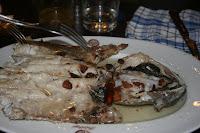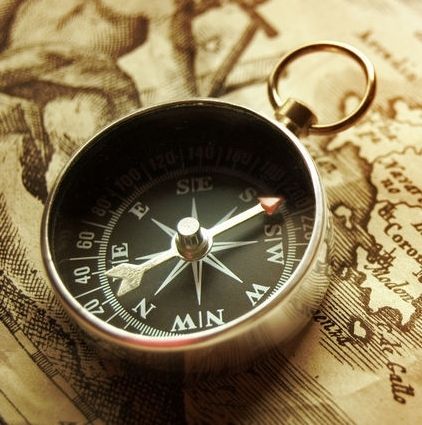I thought I´d put up a short entry to try and catch up on this blog.
I left my group from school yesterday and drove to Arcos de La Frontera in the south of Spain. After I take about 3,000 more photos I will update with a blog on Arcos,etc.

After Barcelona we went to San Sebastian along the north coast in Basque country.
It is incredible; one of the most picturesque places I have ever been. It is situated on a crescent shaped bay called La Concha (a Shell). There are bright white sailboats moored in the harbour, an old town area with a maze of tapas bars and shops and a huge statue of Jesus looks over the whole town from a mountain above.
The town is called Donostia in the Basque language. Everybody here speaks Spanish, though not much English,but Chef Encabo (who is from this area) has been trying to teach us a few words of Vasco (Basque language). Spain has several official languages: Castillian (classic Spanish), Vasco, Catalunyan. I know there is another one but I can´t remember it. There are many different dialects so things sound very different even in Castillian
In Donostia we had the chance to cook in a Basque Cooking Society. While these private clubs are usually the province of the local men, to give them a place to be masters of the kitchen away from the prying eyes of the women, they allowed us to bring in fresh products from the local market and cook a dinner

On our second day in Donostia we left early on the bus to go to a small town called Irún for a festival. The festival celebrates a battle that was fought against the French, which the locals won.

Irún is Chef Encabo´s home town so we got to meet his mother, brothers, and extended family. We arrived into town just after the parade had started. We were told to dress in white and given red hankerchiefs to tie around our necks. Suitably dressed, we marched through the town toward the sounds of cheering and gunshots.

The scene we came upon was like something out of a movie. The parade route, a broad street lined with balconies tumbling down a hill into the main square below, was packed with local people. An army of local men, with a woman on horseback to lead

each neighborhood unit, were marching down the street to the cheers of there relatives on the side, occassionally firing off blank shots into the air. There were thousands of them. Eventually they all arrived in the main town square, where a General on a white horse waited to give the signal.

When the general slashed down with his sword everyone shot their guns off at once and cannons boomed across the town. Pretty impressive.
Then we went to a small local bakery for a quick bathroom break and some luscious, buttery pastries. Finally we got back on the bus and headed out to a cider party on the mountain above the town.

Apparently during this festival no cars are allowed up the mountain. Chef had to arrange for a special pass for our bus. In order to get it we had to fill the bus(we are only 16 people) with locals, so Chef´s family plus some random people who jumped on rode up the mountain with us, chattering loudly in Spanish. Lots of teasing and laughing went on. It got even louder when we came back down after all the cider.

At the top of the mountain there was a little church/restaurant and cider tents set up everywhere. We took pictures from the vista point and then drank the local brew, a tangy/sour fermented cider, with the Encabo family. Everyone was so friendly. As the cider flowed( you are supposed to pour it from a great height to airrate it)our Spanish language skills got better. Or maybe we just thought they did. At any rate people seeme to understand what we were saying and by the end everyone had struck up friendships.

After the festival we went to a local Cider house/restaurant. The area grows alot of apples. The restaurant was way up on hill and was rustically charming.
Inside the main dining area was lined with long communal tables and benches. Everyone sat together. Platters came out and each person ate directly off the platter with their fellow diners. There were no plates, just forks and long baguettes which we used push our food around and sop up the juices. We had a delicious grilled Hake dish and chargrilled steak.

In between each course everyone (and I mean everyone) would get up and tramp into the back where huge barrels of Sidra(cider) lined the cellar. A man would open the tap on the side of the barrel and people would catch the drink in there glass, lining up one after the other with the goal being not to spill any on the floor. We went from barrel to barrel. I guess there is supposed to be a difference between the taste of each barrel but I never noticed any. The cider began to taste better and better however. The food, some of the best I have had in Spain, was perfect. Our hosts were friendly and boisterous.

It was a great day.
Since then we have gone to many places including Vallodolid,Burgos (with a beautiful cathedral that I didn´t get to see because we arrived so late) and finally Segovia.
In Vallodolid, which was the capitol of Spain before Madrid we met our two guides from the local Spanish language and culture institute Fundación de la Lengua Española Ángel and Ada (some of the nicest people we have met and very professional), who showed us around the country for the next few days.
We went to wineries (including a fascinating wine museum at Dinastia Vivanco winery), artisanal cheese makers, huge ham factories and bakeries. But the most interesting night was one of the last that we spent in a tiny village called Cigales, with a famous local musician, eating dinner in a cave!
The man´s name is Paco Díaz. He and his wife have created a local museum with the most amazing collection of instruments from Spain and all over the world - most of which Paco can play perfectly.
Apparently in this area of the country many families dig large underground caves into the side of hills. It looks alot like something out of Lord of the Rings. I expected Hobbits to come out any minute. Tiny doors line the side of the hills and chimneys poke their heads up in random places.
We entered Paco´s cave, descending down a steep set of stairs into a beautiful white stucco apartment. The cave had a large dining room, two small kitchens with wood burning fireplaces and a bedroom. The only thing it didn´t have was a bathroom, but having to use the "open-air facilities" only added to the ambiance.
Paco (who is not a chef but made some of the most delicious food we have had)made many grilled dishes like chorizo and other sausages and the local red wine was passed around in a special vessel called a porron. You tip your head back and pour the wine through the spout into your mouth. This went over really well. Every one relaxed.

Eventually we sang songs while Paco played and his wife plied us with more food. We sang Beso Me Mucho loudly. Chef Encabo sang for us with his impressive tenor voice.
We had a blast.
Ángel and Ada had also set up a special ritual for us to experience. It´s called a Quemada. Paco and Chef took out a large eathenware bowl, filling it with a thick coffee flavored drink, which they lit on fire. The lights were turned out, while Paco played the local bagpipes, and Chef poured the flaming liquid from up high.
Ángel read from a scroll along with Alex (one of our students)about a night of witches and goblins, etc. Melodramatic but pretty cool.
Hello to Jean Morris.
Leslie











1 comments:
Hello to Leslie
I'm glad that you liked Angel and Ada, as well as Paco. Quite something, the cave and the music.
Also glad that you got to meet Joseba's family, I only got to meet his mom, and then tried to converse with her as I know very little Spanish as she knows very little English.
Look forward to some of your pictures of the festival and the sideria as I didn't get to go there in April. J
Post a Comment